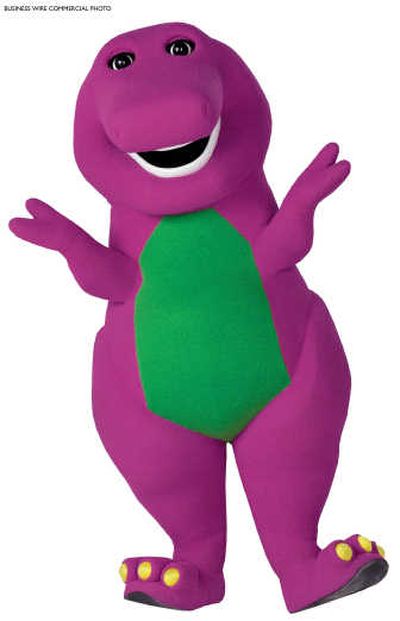No sign of Barney going extinct

HOLLYWOOD – Barney the Purple Dinosaur is routinely held up as the epitome of sappy children’s entertainment. Thousands of anti-Barney Web sites haunt the Internet.
But the children’s TV and music icon must be doing something right.
This year, the giggly T. rex is celebrating 20 years in the biz with a “Big Purple Bus Tour” rolling into multiple cities for meet-and-greet (and hug) events.
Still a highly ranked PBS preschool staple, “Barney & Friends” is one of the most downloaded shows on the network’s 24-hour PBS Kids Sprout video-on-demand service. And he’s still charming legions of little fans with his much-maligned signature, “I Love You, You Love Me” song, and other Barneyisms that trigger winces (and worse) in grown-ups.
“My two rules are ‘No Barney, No Britney,’ ” Amy Trulock told The Wall Street Journal, describing the children’s music she streams on her Web site, Hipyoungparent.com.
Slams don’t ruffle Karen Barnes, the executive producer of “Barney & Friends.” She’s heard them all. “Children get it,” she says, “and a lot of adults get it too. He’s very popular in the DVD market. Obviously parents buy those, so they approve. I think it would be a mistake to change the essence of who he is, because for 20 years children have loved that.”
Indeed, the rights to Barney’s home videos, which have sold in the tens of millions, were snapped up from London-based owner HIT Entertainment recently by independent film distributor Lionsgate, along with other high-profile HIT children’s shows for distribution in the U.S. and Canada.
It’s been a long time, though, since Barney, who transforms in each episode from a stuffed toy into his big, pillowy self, was the hot thing in children’s entertainment.
He’s now one preschool heavyweight among many, competing with “Sesame Street,” “Blue’s Clues,” “Dora the Explorer,” “Teletubbies,” “Bob the Builder” and “Thomas the Tank Engine,” to name just a handful.
Musically, the repetitive ditties that Barney sings seem, well, positively prehistoric to many, compared to an expanding roster of adult-friendly “kindie” artists that include highly regarded former Del Fuegos rocker Dan Zanes and pop tune purveyors Kidz Bop, which cracked Billboard’s top 10 album list in February.
Yes, the songs are simple and repeated “a lot,” Barnes patiently explains, “because kids feel a sense of accomplishment at that age. They can watch something several times and then they can do it.”
Created in 1987 by former teacher Sheryl Leach, “Barney & Friends” took off on home video the following year. The show landed at PBS in 1992, and its rotund star scored a seven-figure deal with EMI Records Group in 1993. From 1996 to 1998, Barney ranked as Billboard’s top children’s artist.
In 2002, HIT Entertainment bought Barney’s producing company, Lyrick Studios, for $275 million.
Along the way, in addition to older “real” kids who appear on the show as role models for younger viewers, Barney acquired dino-kid sidekicks Baby Bop and B.J. and an expanded world that includes a park set and video footage of children in various locales.
A new music curriculum added multicultural emphasis to the show in 2006. It ushered in a new character, a music-loving hadrosaur named Riff, and a shorter format with interstitial bridges between two 12-minute episodes. (This year, the episodes returned to a 30-minute format.)
The key to Barney’s longevity is no mystery, Barnes says. “He’s a gentle soul, he’s very uncomplicated. It’s about the simple things that a child appreciates at that age.”
Tenets of child development frame the show, she stresses.
With a target age range of 2 to 4, the focus is on vocabulary, colors, shapes, numbers and the ABCs; such social skills as sharing, caring and playing together; and movement, “where a lot of the music comes in,” Barnes says. “We actually do hit all those different areas show by show.”
Dorothy Singer, senior research scientist emeritus of Yale University’s psychology department and co-director of Yale’s television research center, backs that claim.
“We have now done a content analysis of every Barney program that’s been on the air,” she says. “Every summer we sit with a group of five psychologists and look at every show that’s about to come out.”
The purpose, she explains, is to let the producers know “what we feel is developmentally out of place – and it’s rare that we find anything we can criticize.”
“I really think it’s a very thoughtful program,” Singer adds. “When people say he’s so sweet and saccharine, they said the same thing about Fred Rogers, too. But these programs are for children.”